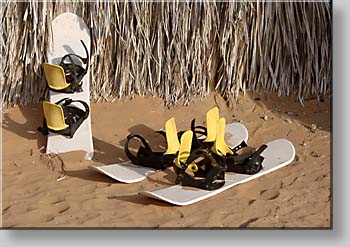Into the desert - Wahiba Sands

The sand desert Ramlat al-Wahiba - or Wahiba Sands - is a relatively small desert. Because it keeps within reasonable limits, scientists like it as a model desert. From north to south it is approximately 250km and from east to west only 80km. Not much from a global point of view but quite a distance if one gets stuck with a car. Mobile phones only work close to camps, where there are transmitting masts. There are two unique features of the Ramlat al-Wahiba: One is sand free areas where trees grow and rare species of gazelles can live and the other is petrified sand dunes "Aeolianite". We did not go to those special places.
Once again we hired Ya'qoub the driver who drove us through the mountains and canyons. He told us that he did special training for desert driving - a requirement of oil-companies which he works for for most of the year.
Before entering the sand the air pressure in the tyres has to be decreased to provide grip in the sand. Most of the time Ya'qoub drove at up to almost 100km/h through the sands. The sensation was something like floating. We only slowed down if we had to cross dunes, and Ya'qoub changed the 4WD to more power and less speed. The floating sensation changed to a feeling like being in a boat which was riding a big wave. While going down the sand-dunes it is very important to stay on the line of steepest descent, to prevent the car from rolling over - in addition it is advisable not to accelerate or brake. With the right gear only the engine should brake.

For me and Silvia it was the first time in our life in a sand desert. We were so fascinated by the fine sands that we behaved a bit like young dogs romping around in fresh snow. Moderate winds blew the fine sand everywhere, forming nice coloured patterns und generating ripples and dunes. After a while we felt the crunching sensation of fine sand between our teeth.

Soon we reached a Bedouin camp. The people live in extremely simple conditions. But they were able to survive in that extraordinary dry and hot climate. In summer, air temperatures of 45 ° C are common and can rise to 50°C.
We were invited for some very strange coffee with a cardamom flavour and bought a few souvenirs.





After we visited the Bedouins we drove further to the Al-Raha Tourism Camp. It is located more than 20 km inside the Wahiba Sands. It is possible to stay there overnight or try strange kinds of sports like sand boarding. The 4WD drivers show their skills by driving up and down the high sand dunes just east of the camp, as we saw at the car races there. Ya'qoub drove us at the top of the dune. But - as mentioned above - the day was windy. Steep ridges of powdery fine sand had been freshly deposited at the top of the dunes like snow leewards of a summit. There was no way to get over this ridge without risking getting stuck if we went too slowly or to roll over if we went too quickly. After a close look Ya'qoub decided to go down half of the dune the way we'd come up, to meet the line of steepest descent half way up. Nevertheless it was a breathtaking experience.




